Incandescence
Nova Ami and Velcrow Ripper
2024
| 105 min 22 s & 60 min versions available
Documentary Feature
English
Awards and Festivals
Special Jury AwardSeoul International Environmental Film Festival, South Korea (2025)
Official SelectionPlanet in Focus International Environmental Film Festival, Toronto, Canada (2024)
Official SelectionVictoria Film Festival, Canada (2025)
Official SelectionSanta Barbara International Film Festival, U.S.A. (2025)
Official SelectionKamloops Film Festival, Canada (2025)
Official SelectionDocLands Documentary Film Festival, San Rafael, U.S.A (2025)
A National Film Board of Canada Production
Log Line
Incandescence is an immersive cinematic experience that weaves together on-the-ground footage with extraordinary stories of survival and adaptation that transform our understanding of wildfire.
Wildfires are burning with increasing intensity around the world. Following the rhythms of the seasons, Nova Ami and Velcrow Ripper’s Incandescence is an immersive cinematic experience, weaving on-the-ground footage with extraordinary stories of survival and adaptation that transform our understanding of wildfire. The film takes shape from the ancient patterns embodied in fire: destruction, aftermath and rebirth. From the flightpath of bees to an osprey’s aerial perspective, floating over the landscape: the Earth comes back.
Long Synopsis
Every summer, wildfires increasingly ravage places around the globe, darkening the skies with thick smoke and reducing communities to little more than ash and debris.
Award-winning directors Nova Ami and Velcrow Ripper (Metamorphosis) weave together immersive on-the-ground footage with first-person accounts from Indigenous Elders, first responders, and ordinary people forced to react to a rapidly evolving ecosystem in the feature documentary Incandescence.
As climate change continues to escalate, full suppression measures have largely failed, leading to bigger, more intense mega-fires. But there is another way. Indigenous knowledge keepers explain that the First Nations people traditionally used controlled burns to regenerate the land. As one woman explains, fire is like a grizzly bear running to stay alive. But instead of fighting this insatiably hungry beast, working with nature transforms fire’s capacity to destroy into a powerful force for growth and renewal.
Following the rhythms of the seasons, Incandescence takes shape from the ancient patterns embodied in fire: destruction, aftermath, rebirth. Many plants and animals have adapted to use fire in their life cycle. Some trees species require heat to release their seeds, while other fire-activated plants make use of the nutrients released in the soil bank to bloom. Honouring the experience of both human and non-human inhabitants, the film documents extraordinary stories of survival and adaptation in the forest mosaic. From the flightpath of bees to an osprey’s aerial perspective, floating over the landscape: the Earth comes back.
Inside this intense and lushly realized cinematic experience, something else begins to emerge. A febrile spirit rising from the ashes with a collective and resilient approach to our mutable future, Incandescence transforms our understanding of fire from destruction and disaster into a kind of profound illumination, lighting the way towards new life and hope.
Q&A with the directors
1. Although we tend to think of fire as a force of destruction and chaos, Incandescence makes the point that fire is a necessary part of a forest’s lifecycle. How has your own understanding of the role that fire plays in the larger scope of environmental and planetary patterns changed or evolved in the process of making the film?
We conceived of the idea of Incandescence with the intention of exploring our relationship to fire in the context of increasing megafires due to climate change. As the process of making the film unfolded, our understanding of fire evolved, especially as we spent time learning from Indigenous fire keepers, whose ancestors had practised cultural burning for thousands of years. We knew that fire can be scary, fire can be dangerous and destructive. But fire is also good for the land, when we work with it. Forests that have unburnt fuel accumulating, combined with climate change, have created a deadly combination in which fires burn hotter and bigger. The low-intensity fires of a prescribed burn reduce fuel load, rejuvenate the soil and activate certain pine cone species to release their seeds. The banning by settlers of traditional practices has contributed to the rise of megafires. Getting back to cultural burning practices, and a collaborative approach between wildfire agencies and Indigenous fire keepers, are important ways forward as we navigate this era of increasing wildfire risk.
2. The film takes a deeper focus on the experiences of the non-human world (plants, animals). How important was it to shift the perspective away from human experience to offer a wider and more encompassing picture of how wildfires impact the natural world?
It was very important for us to explore how wildfire impacts ecosystems, to include the perspectives of a range of creatures and plants, as we so often see the world through a fragmented, human lens—and often even narrower than that, through the lens of our particular identity. We need to see the world as the complex system it is. For Incandescence, we wanted to extend it beyond humans, as the story is bigger than us. The animals featured include beavers, who are known as ‘nature’s firefighters’ because the wetlands they create help to slow the spread of fire. Deer, coyotes, bears, bees, bighorn sheep and osprey all feature in the film, moving through the cycles of the seasons, including wildfire season, and are all impacted by fires that are burning hotter and longer than before.
3. What were the particular challenges of filming in environments where wildfires were taking place? Did your team collaborate closely with frontline workers to ensure safety as well as access during the filmmaking process?
The biggest challenges of working on a film about wildfires were safety, access and ensuring we did not get in the way of emergency response efforts. We collaborated closely with an independent wildland firefighting outfit, Rider Ventures, as well as BC Wildfire, and safety was always their top concern. We participated in safety briefings, wore proper personal protective equipment (PPE) and followed strict safety protocols that were overseen by the fire-crew leaders.
Rider Ventures called us their ‘film family’ and truly embraced the project. BC Wildfire also supported our film with two camera people who are experienced wildland firefighters. Because of their training, they were able to capture images in situations that wouldn’t have been possible for our crew, getting right up close to some major fires. We also collaborated with local residents who are experienced videographers and captured some stunning footage—such as David Newcomb, a former news cameraperson who was right there filming in the early days of the White Rock Lake fire.
4. As megafires become a regular occurrence, impacting greater numbers of people in immediate and often tragic fashion, do you see this leading to increased awareness of climate change? How do you see Incandescence playing a part in this evolving understanding of the changing nature of the planet?
We can’t ignore the causes that contribute to the regular occurrence of megafires. There is definitely an increased awareness of climate change. As humans we need to dive into adaptation and mitigation. The two need to happen at once and are not mutually exclusive.
Incandescence offers an immersive, firsthand experience through communities impacted by wildfires, an exploration of our relationship to fire and how that relationship is impacted by the changing nature of our planet. Through this experience we hope to inspire empathy, deeper levels of understanding and action.
5. Do you think that crises like megafires can act as an inflection point, bringing people and communities together to search for better and more sustainable solutions?
As we experience more and more climate events such as megafires, we can direct our attention to how to preserve and protect our communities and prevent future events from happening. We can look at building our communities as a path to sustainability. Supporting each other, knowing each other, sharing ideas. In the immediate aftermath, being able to provide mental health support for those directly impacted, housing and living support for those who are displaced. And moving into the future, working together with Indigenous practices with the land, re-building and constructing with fire-resistant and sustainable materials, fuel mitigation and moving away from using fossil fuels. Crisis can bring out the best in us, as we learn to work together for our own survival.
Poster
Images
Loading...
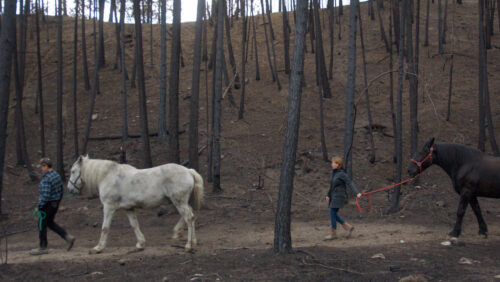
Download
Loading...
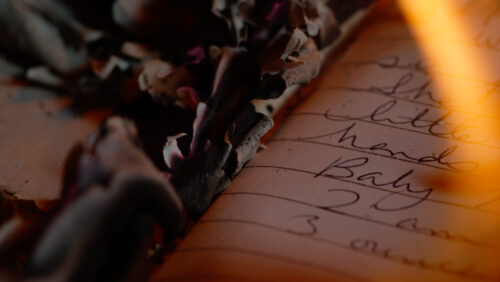
Download
Loading...
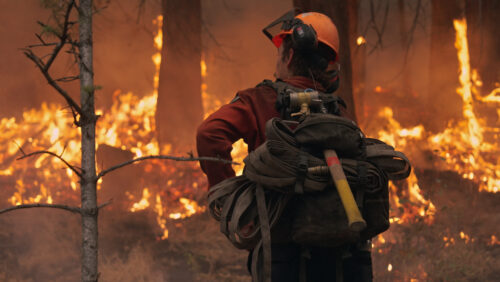
Download
Loading...
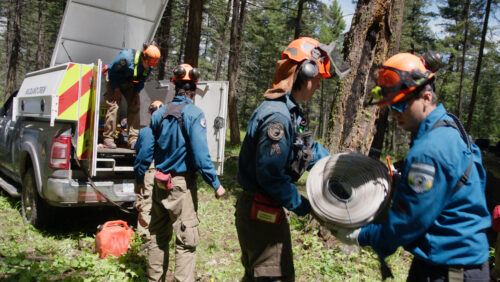
Download
Loading...
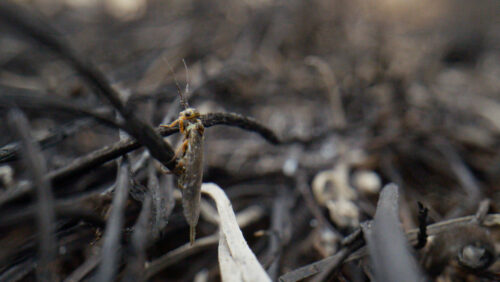
Download
Loading...
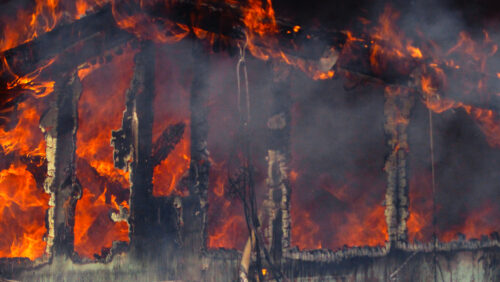
Download
Loading...

Download
Loading...

Download
Loading...
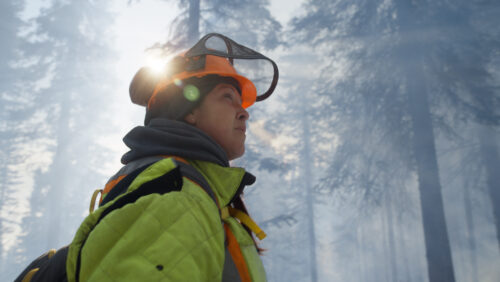
Download
Trailer
Excerpts
Team
Nova Ami
Writer/Director/Producer
Photo
Photo : Grant Baldwin
Velcrow Ripper
Writer/Director/Producer/Cinematographer
Photo
Photo : Grant Baldwin
Shirley Vercruysse
Producer, Executive Producer
Photo
Photo : Myriam Frenette
Credits
Filmed with respect and gratitude on the traditional, unceded land
of the Syilx Okanagan People
Written and Directed by
Nova Ami and Velcrow Ripper
Producer
Shirley Vercruysse
Line Producer
Jennifer Roworth
Director of Photography
Vince Arvidson
Editor
Hart Snider
Sound Designer
Velcrow Ripper
Featuring
(In Order of Appearance)
Dora Alexis
Jeremey Neufeld
Jaclyn Moore
Craig Moore
Denise Jervah
Tiffany Wilson
Kara Marchand
Kayden Marchand
William V. Wilson
Michelle Maisonneuve
Robert Hugh
Rachel Casponi
David Newcomb
Anita Jacobsen
Vern Clemah
Kevin Dalgarn
XWESTKIN
James Pepper
Tim Lezard
Fred Louis
John Sawatzky
Yenny Peralta
Jeff Findlay
Crystal Findlay
Graheme Wilson
Jason Brolund
Anne Farnan
Antonio Ortega
Kevin Parkinson
Ben Sandy
Sound Recordist
David Pullmer
Additional Sound Recording
Alex Shamku
Additional Camera
Jan Vozenilek
Peter Planta
Maxwel Hohn, Wildlife Cinematography
Billy Stevens, BC Wildfire Service
Adam Buchanan, BC Wildfire Service
Camera Assistant
Jamie Cottington
Elena Jean
Phantom Unit
Phantom Unit DOP
Michael Dinsmore
Phantom Unit Camera Operator
Luke Campbell
Phantom Unit Camera Assistant
Min Woo Lee
Special Effects Technician
Peter Reimchen
Special Effects Assistant
Jak Hedley
Stills Photographer
Chloe Langmaid
Production Manager
Mia Jagpal
Production Coordinator
Maddy Chang
Lee Clapp
Calvin Serutoke
Nicolas Ayerbe Barona
jas calcitas
Researcher
Caroline Coutts
Story Editor
Hart Snider
Assistant Editor
Ricardo Ochoa
Title & End Credits Graphics Designer
Eoin Duffy
Technical Coordinator
Wes Machnikowski
Visual Effects
Trevor Gent
Re-Recording Mixer
Miguel Nunes
Dialogue Editor
Miguel Nunes
Foley Artists
Alex Macia & Devon Quelch
Foley Editor
Jake Kerr
Mix Facility
Maverick Post Group Inc
Additional Sound FX
Celso Machado
Senior Colourist
Claudio Sepulveda
Online Facility
Picture Shop
Thank You
Rider Ventures
Jaclyn Moore
Craig Moore
BC Wildfire Service
Jean Strong
Ashley Davidoff
Nicole Bonnett
Animal Lifeline Emergency Response Team Society
BC Wildfire Service
Broken Rail Ranch
Desert Park Exhibition Society
Mennonite Disaster Services
Okanagan Indian Band
Okanagan Indian Band Fire Department
Penticton Indian Band
Rider Ventures
Two Brothers Mexican Restaurant
West Kelowna Fire Rescue
Abram Reimer
Alexandre DeBellefeville
Alyia Toews
Amanda Nadeau
Amy Cardinal Christianson
Antoine Jacques
Ashley Jones
Audrey Harry
Beau Michaud
Benjamin Paul
Bill Wacey
Blaze Lezard
Bonnie Lawrence
Brad Mailhot
Brett Cecutti
Brian Muselle
Brianna Wiebe
Bryden Winsby
Carling Anderson-Servage
Caroline Rahkola
Casey Jones
Catherine Lafontaine
Chad Desjarlais
Chance Breckenridge
Cheryl Paul
Cheyenne Sampson
Chloe Mayes
Chris Bonneau
Chris Czajkowski
Chris Joe
Chris Manuel
Clay Schultz
Cody Milne
Cody Peden
Cole Warkentin
Colleen Marchand
Dan Wilson
Daryl Meyers
Dave Lawrence
David Cullen
Dean Schreiber
Denis Sabourin
Denise Derosier
Derrick Phillip
Don O’Neill
Doug Harrison
Draven Frank
Eithan Brodeuv
Eli Klassen
Emma Dupuis
Floyd Baptiste Jr.
Franco Benti
Frank Arnonse
Fred Reid
Garrett Black Thomas
Garrett Lawrence
Gordy Walls Good
Grace Toews
Grant Braun
Gwen Cornelsen
Hal Sundby
Hannah Cober
Helen Wilson
Helene Ruel
Ian Dyer
Ike Epp
Jacob Astren
Jacob Sims
Jaden Toews
James Rendall
Jamie von Sacken
Jasio Poppe
Jason Allison
Jason Satterthwat
Jean-Yves Doucet
Jen Allgeier
Jennifer Seminoff
Jeremy Harder
Jim Kane
Jim Thompkins
Joe Hartman
Joel Baker
Jonathan Thomson
Jordan Kober
Josh Hyer
Juel Rudyk
Karen Alstad
Kate Latimer
Kathleen Minogue
Kelvin Alexis
Kevin Aertsen
Kevin Bennett
Kevin Reed
Koi Epp
Kolton Leslie
Konnor Peden
Laura Dunn
Lazlo De Courcy
Leann Manuel
Len Peters
Linda Boyle
Linda Hanton
Linda Schultz
Lisa Renaud
Liza Magee
Logan Gottwald
Logan Imrich
Lucas Flundra
Lucas Karlsson
Lucas Paul
Madden Wiebe
Mariah Chapman
Mark Healy
Mason Lambert
Matt Webber
Max Waters
Michelle Hamilton
Mike Doherty
Mike McQueen
Mitch Taylor
Monica Reid
Natalie Perchie
Nate Froese
Nathan Bartel
Nathan Dpmarchuk-White
Natian Bonneau
Nelson Phillip
Nick Nilsen
Nikky Haegele
Noam Janes
Oarien Ottesen
Orrin Tyrell Jessop
Owen Klassen
Patrice and George Russu
Pete Wise
Priscilla Epp
Rachelle Klassen
Ralph Huges
Randal Swakum
Raymond Paul
Riley Billy
Riley Fehr
Rita Edwards
Robert Allen Jack
Robert Farnan
Robert Wagner
Rohna Dara Lanaway
Royce Boskers
Ryan Cope
Ryan Taschuk
Rylan Toews
Samaritan’s Purse
Santiago Becevva
Sebastian Elias
Serge Leblanc
Sharon Cullen
Skylar Richard
Sofia Epp
Sue George
Tara Besler
Taulbee Jack
Taylor Jackson Oliveira
Ted Peden
Timothy Shuter
Toby Peters
Tony Antione
Travis Stump
Tristan Sailor
Ty Weaver
Tyler Algar
Tyler Marchand
Special Thanks
PhatCat Ripper-Ami
Emily Ami
Carla Ripper
Lise Sheridan
Archival Footage
BC Wildfire Service
Conair
Crystal and Jeff Findlay
David Newcomb
Global News
Government of British Columbia
Jan Vozenilek
Kyle Brittain
Miracle Media Inc.
Tiffany Wilson
Transparent Film
Yenny Peralta
Pond5 stock media provided by
All_Around_Project
Hdnaturefootage
k_SergiUs
Trekkerphotos
Stockshooter
Wirestock
Producer, Development
Teri Snelgrove
Marketing Manager
Kay Rondonneau
Publicist
Katja De Bock
Studio Administrators
Nathan Conchie
Carla Jones
Executive Producer
Shirley Vercruysse
DGC, WGC
©2024 National Film Board of Canada
-
About the NFB
For more than 80 years, the National Film Board of Canada (NFB) has produced, distributed and preserved those stories, which now form a vast audiovisual collection—an important part of our cultural heritage that represents all Canadians.
To tell these stories, the NFB works with filmmakers of all ages and backgrounds, from across the country. It harnesses their creativity to produce relevant and groundbreaking content for curious, engaged and diverse audiences. The NFB also collaborates with industry experts to foster innovation in every aspect of storytelling, from formats to distribution models.
Every year, another 50 or so powerful new animated and documentary films are added to the NFB’s extensive collection of more than 14,000 titles, half of which are available to watch for free on nfb.ca.
Through its mandate, its stature and its productions, the NFB contributes to Canada’s cultural identity and is helping to build the Canada of tomorrow.
Media Relations